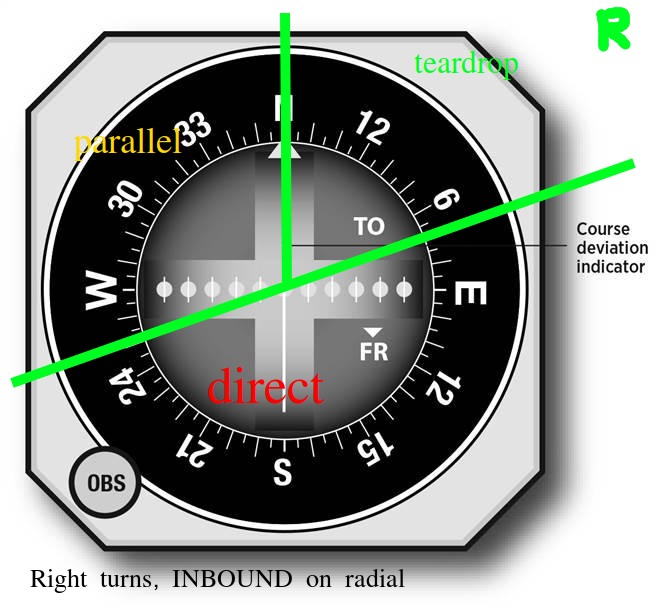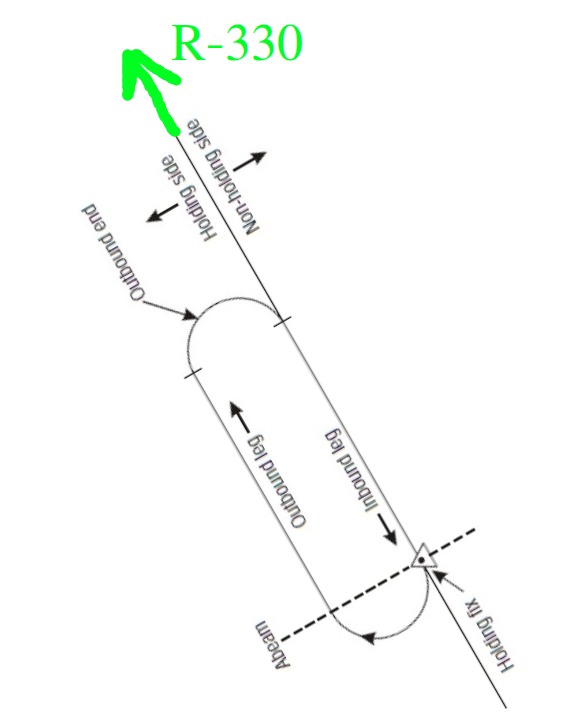This page was created mainly for memory refreshment: I made some notes about the most basic knowledge for an IR holder. It can be useful for LPC/IPC.
Holding Procedures

Mentally draw an inverted T on your CDI. For right turns, raise the right side of the horizontal bar (20 degrees counter-clockwise). The entry type depends on the sector in which your assigned radial falls in.
We assume the holding course is reciprocal to the radial.
For left turns, raise the left side of the horizontal bar.
For holding on the radial outbound, use the reciprocal radial.

Example: heading N (like on the picture), holding 300 inbound, right turns. We have to use parallel entry because 300 is in the upper-left sector. We can clearly see if we are heading north and want to hold inbound on radial 330, we have to use parallel entry.
Recency
EASA IR: 12 month validity, LPC can be accomplished in 90 days before the date of expiration. Can be done only with IRE/CRE. Begins at the day of LPC, ends at the last day of month.
FAA IR: 6 instruments approaches plus holding, tracking and interception during the previous 6 months. If that is not done, during the following 6 months the same with a safety pilot. After that only IPC with DPE or CFII.
PIC recency: current medical, current class/type rating (for FAA it means BFR for ASEL/AMEL), current IR, for night with passengers 2 (EASA) or 3 (FAA) full stop landings at night during previous 3 months.
Medical
IMSAFE
EASA 1st class: for CPL, 17-39 years – valid for 12 months, 40-59 years – valid for 6 (single pilot CAT with passengers) or 12 (multi-pilot, FI) months, 60+ years – 6 months. Revalidation is possible in no more than 45 days in advance.
EASA 2nd class: 16-39 – 60 months (and not valid after 42), 40-49 – 24 months (and not valid after 51), 50+ – 12 months.
FAA: to be added
Required Equipment
EU No 800/2013, or Part-NCO.
- Type certificate: Kinds of operation
Does the type certificate data sheet or POH list IFR as a possible kind of operation? - Basic instrumentation
Does the airplane fulfill NCO.IDE.A.125?- Magnetic compass;
- Clock displaying h, min, s (wrist watch is sufficient);
- Altimeter;
- Airspeed indicator;
- Vertical speed indicator;
- Turn and slip indicator;
- Attitude indicator;
- Directional gyro or other stabilized heading indicator;
- Outside air temperature;
- Vacuum pressure gauge;
- Pitot heat.
- Communication and transponder equipment
Does the airplane fulfill NCO.IDE.A.190/200?- Two-way radio, only if required by airspace or RMZ (190);
- Transponder, only if required by airspace or TMZ (200).
- Navigation equipment
Does the airplane fulfill NCO.IDE.A.195?- Navigation equipment enabling to proceed according to the ATS flight plan and airspace requirements (except VFR by reference to landmarks, a.k.a. pilotage);
- Sufficient navigation equipment to have a backup (e.g. any combination of two independent navigation systems: two CDIs, CDI/ADF, CDI/IFR GPS, possibly even radar vectors plus only one navigation system, etc.);
- If landing in IMC, the equipment required for the approach;
- PBN specification (not necessary).
Maintenance
EASA: transponder test within the last 24 months; pitot-static system test within the last 24 months.
FAA: annual, 100h inspection, transponder 24 months, pitot-static system 24 months, VOR 30 days, ELT 50% batt or 1h use of ELT.
Weather
EASA VFR: ABCDE above 3000 ft MSL or 1000 ft AGL 1000 ft vertically, 1500 m horizontally; visibility 5 km below 10000 ft, 8 km at and above 10000. FG below 3000 ft MSL or 1000 ft AGL clear of clouds and surface in sight, 5 km visibility.
EASA SVFR: visibility 1.5 km, CTR, 140 kt or less.
EASA IFR planning: destination RVR vis is above minimums, and for non-precision ceiling about MDA +-1h of arrival; alternate CAT II or CAT III – CAT I vis, CAT I – NPA RVR/vis and ceiling above MDH, NPA – NPA RVR/vis + 1000 m, ceiling MDH + 200 ft, circling- circling.
EASA IFR: alternate is NOT required if VMC will prevail OR more than one independent runway and at least one has instrument approach OR isolated.
Fuel
EASA: Taxi Trip to the CAFAE: Contingency – 5% of trip or needed for replanning but not less than 5 min hold at 1500 ft over destination; Alternate – missed, climb. descend, approach, if no alternate – 15 min at 1500 fs over destination, if isolated – 45 min + 15% of time at cruising level or 2 hours (piston) or 2 hours at cruising level (turbine); Final reserve – 45 min (piston) or 30 min at 1500 ft (turbine); Additional – fuel to alternate from the most critical point in case of failure + 15 min holding at 1500 ft + approach and landing; Extra – at the PIC discretion.
FAA VOR accuracy
- VOT +- 4 degrees;
- Ground +- 4 degrees;
- Airborne +- 6 degrees;
- Dual within 4 degrees.
Takeoff minimums
EASA: below 800 m RVR is LVO (special training and airport approval); 500 m RVR no special markings, the pilot can decide; 400 m RVR day – RW edge lights or RW centerline markings (day) / lights (night); 300m RVR – special training on a simulator, day RW edge lights AND RW centerline markings, night RW end lights AND (RW edge lights OR RW centerline lights); 200 m RVR – RW edge lights AND RW centerline lights; 150 m RVR – RW edge lights AND RW centerline lights AND 3 RVRs; 125 m RVR – the same + high intensity lights + standard spacing; 75 m RVR – the same and all three RVRs should be above 75 m.
Course
West is even, east is odd. At and above 290 non-RVSM 2000 ft separation between the opposite directions.
Altitude
MEA, MOCA, MCA, MRA, MAA, MSA, OROCA.
Holding
ICAO:
- Up to 14000 ft: 230 kt
- above 14000 ft to 20000 ft: 240 kt
- above 20000 ft to 34000 ft: 265 kt
- Above 34000 ft: M0.83
FAA:
- Up to 6,000 ft MSL: 200 kt
- From 6,001 to 14,000 ft MSL: 230 kt
- 14,001 ft MSL and above: 265 kt
Lost communications
squawk 7600
VMC – continue in VMC and land at the nearest suitable aerodrome;
EASA IMC:
- Unless otherwise prescribed on the basis of a regional air navigation agreement, in airspace where procedural separation is being applied, maintain the last assigned speed and level, or minimum flight altitude if higher, for a period of 20 minutes following the aircraft’s failure to report its position over a compulsory reporting point and thereafter adjust level and speed in accordance with the filed flight plan; or
- In airspace where an ATS surveillance system is used in the provision of air traffic control, maintain the last assigned speed and level, or minimum flight altitude if higher, for a period of 7 minutes following: i) The time the last assigned level or minimum flight altitude is reached; or ii) Time the transponder is set to Code 7600 or the ADS-B transmitter is set to indicate the loss of air-ground communications; or iii) The aircraft’s failure to report its position over a compulsory reporting point; whichever is later and thereafter adjust level and speed in accordance with the filed flight plan;
- When being vectored or having been directed by ATC to proceed offset using Area Navigation Systems without a specified limit, proceed in the most direct manner possible to rejoin the current flight plan route no later than the next significant point, taking into consideration the applicable minimum flight altitude;
- Proceed according to the current flight plan route to the appropriate designated navigation aid or fix serving the destination aerodrome and, when required to ensure compliance with 5), hold over this aid or fix until commencement of descent;
- Commence descent from the navigation aid or fix specified in 4) at, or as close as possible to, the expected approach time last received and acknowledged; or, if no expected approach time has been received and acknowledged, at, or as close as possible to, the estimated time of arrival resulting from the current flight plan;
- Complete a normal instrument approach procedure as specified for the designated navigation aid or fix; and
- Land, if possible, within 30 minutes after the estimated time of arrival specified in 5) or the last acknowledged expected approach time, whichever is later.